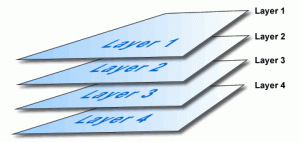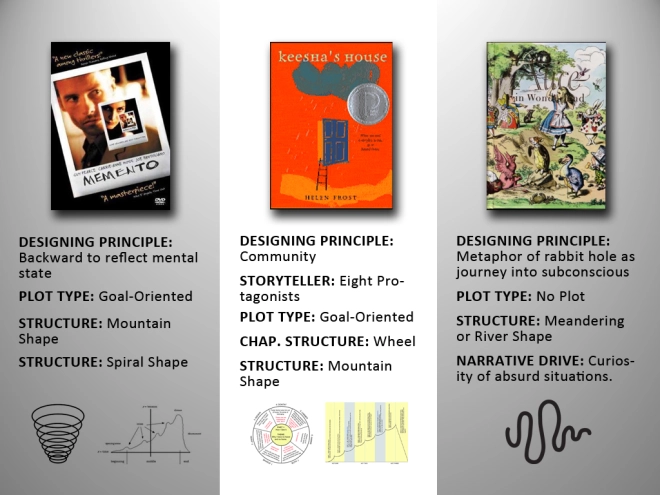 I’ve spent the last two months talking all about classical design, alternative structures and plots, and designing principles! Hopefully you’ve seen that there are innumerable design possibilities at your fingertips. But as I walked us through this series, I’m sure a few of you read my posts and thought to yourself: Doesn’t that story fit into multiple types of structure? For example, as I explained that The Godfather uses a fairy-tale structure, you might have been thinking: But Ingrid, it also uses the mountain structure!
I’ve spent the last two months talking all about classical design, alternative structures and plots, and designing principles! Hopefully you’ve seen that there are innumerable design possibilities at your fingertips. But as I walked us through this series, I’m sure a few of you read my posts and thought to yourself: Doesn’t that story fit into multiple types of structure? For example, as I explained that The Godfather uses a fairy-tale structure, you might have been thinking: But Ingrid, it also uses the mountain structure!
To which I’d say: You’re right!
Which brings me to my final point in this series: design and structure are layered. You won’t necessarily pick on design concept and be done.
In the film Memento, the designing principle uses a backwards structure to reflect short term memory. But it also has a goal-oriented plot and a mountain structure. Only the major structural beats are flipped. If the story was told forward, what would be considered the inciting incident becomes the climax when it’s told backwards. Additionally, because the story revisits events of the past, again and again, you could also consider this movie to have a spiral structure.
Helen Frost’s novel Keesha’s House is also layered. It’s told with eight protagonists as a portrait of a community and each chapter uses a wheel structure to unify the characters through a theme. But the structure of the whole novel still uses a mountain escalation as each chapter introduces new obstacles. It’s also a goal-oriented plot: to find a safe place to live.

Stories are layered. And you may find, like me, that the story you’re trying to tell doesn’t fit easily into a three act structure or the hero’s journey. Or maybe it does. And it’s okay if it does. Just make sure that’s a choice you’ve made because it’s right for your story.
Screenwriter Charlie Kaufman said in a lecture to the British Film Academy that “there’s no template for a screenplay, or there shouldn’t be. There are at least as many screenplay possibilities as there are people who write them. Don’t let anyone tell you what a story is, what it needs to include or what form it must take.”
Only you know how to tell your story and only you know how to design it.
Thanks for reading this series!


 I’ve spent the last two months talking all about classical design, alternative structures and plots, and designing principles! Hopefully you’ve seen that there are innumerable design possibilities at your fingertips. But as I walked us through this series, I’m sure a few of you read my posts and thought to yourself: Doesn’t that story fit into multiple types of structure? For example, as I explained that The Godfather uses a fairy-tale structure, you might have been thinking: But Ingrid, it also uses the mountain structure!
I’ve spent the last two months talking all about classical design, alternative structures and plots, and designing principles! Hopefully you’ve seen that there are innumerable design possibilities at your fingertips. But as I walked us through this series, I’m sure a few of you read my posts and thought to yourself: Doesn’t that story fit into multiple types of structure? For example, as I explained that The Godfather uses a fairy-tale structure, you might have been thinking: But Ingrid, it also uses the mountain structure!
To which I’d say: You’re right!
Which brings me to my final point in this series: design and structure are layered. You won’t necessarily pick on design concept and be done.
In the film Memento, the designing principle uses a backwards structure to reflect short term memory. But it also has a goal-oriented plot and a mountain structure. Only the major structural beats are flipped. If the story was told forward, what would be considered the inciting incident becomes the climax when it’s told backwards. Additionally, because the story revisits events of the past, again and again, you could also consider this movie to have a spiral structure.
Helen Frost’s novel Keesha’s House is also layered. It’s told with eight protagonists as a portrait of a community and each chapter uses a wheel structure to unify the characters through a theme. But the structure of the whole novel still uses a mountain escalation as each chapter introduces new obstacles. It’s also a goal-oriented plot: to find a safe place to live.

Stories are layered. And you may find, like me, that the story you’re trying to tell doesn’t fit easily into a three act structure or the hero’s journey. Or maybe it does. And it’s okay if it does. Just make sure that’s a choice you’ve made because it’s right for your story.
Screenwriter Charlie Kaufman said in a lecture to the British Film Academy that “there’s no template for a screenplay, or there shouldn’t be. There are at least as many screenplay possibilities as there are people who write them. Don’t let anyone tell you what a story is, what it needs to include or what form it must take.”
Only you know how to tell your story and only you know how to design it.
Thanks for reading this series!


 I’ve spent the last two months talking all about classical design, alternative structures and plots, and designing principles! Hopefully you’ve seen that there are innumerable design possibilities at your fingertips. But as I walked us through this series, I’m sure a few of you read my posts and thought to yourself: Doesn’t that story fit into multiple types of structure? For example, as I explained that The Godfather uses a fairy-tale structure, you might have been thinking: But Ingrid, it also uses the mountain structure!
I’ve spent the last two months talking all about classical design, alternative structures and plots, and designing principles! Hopefully you’ve seen that there are innumerable design possibilities at your fingertips. But as I walked us through this series, I’m sure a few of you read my posts and thought to yourself: Doesn’t that story fit into multiple types of structure? For example, as I explained that The Godfather uses a fairy-tale structure, you might have been thinking: But Ingrid, it also uses the mountain structure!



Love the chart. This has been a great series, Ingrid! I’d say my novel has the goal-oriented mountain shape. But I’d like to experiment more in another novel.
You always need to pick the structure that’s right for your novel.
I love experimentation! Have fun with the next projects!